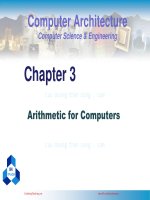kiến trúc máy tính võ tần phương chương ter02 0 data representation sinhvienzone com
Bạn đang xem bản rút gọn của tài liệu. Xem và tải ngay bản đầy đủ của tài liệu tại đây (1.08 MB, 29 trang )
dce
2013
COMPUTER ARCHITECTURE
CSE Fall 2013
Faculty of Computer Science and Engineering
Department of Computer Engineering
BK
TP.HCM
Vo Tan Phuong
/>
CuuDuongThanCong.com
/>
dce
2013
Chapter 2
Data Representation
CuuDuongThanCong.com
Computer Architecture – Chapter 2
/>
© Fall 2013, CS
2
dce
2013
Presentation Outline
•
•
•
•
•
•
•
•
•
•
Positional Number Systems
Binary and Hexadecimal Numbers
Base Conversions
Integer Storage Sizes
Binary and Hexadecimal Addition
Signed Integers and 2's Complement Notation
Sign Extension
Binary and Hexadecimal subtraction
Carry and Overflow
Character Storage
CuuDuongThanCong.com
Computer Architecture – Chapter 2
/>
© Fall 2013, CS
3
dce
2013
Positional Number Systems
Different Representations of Natural Numbers
XXVII
27
110112
Roman numerals (not positional)
Radix-10 or decimal number (positional)
Radix-2 or binary number (also positional)
Fixed-radix positional representation with k digits
Number N in radix r = (dk–1dk–2 . . . d1d0)r
Value = dk–1×r k–1 + dk–2×r k–2 + … + d1×r + d0
Examples: (11011)2 = 1×24 + 1×23 + 0×22 + 1×2 + 1 = 27
(2103)4 = 2×43 + 1×42 + 0×4 + 3 = 147
CuuDuongThanCong.com
Computer Architecture – Chapter 2
/>
© Fall 2013, CS
4
dce
2013
Binary Numbers
• Each binary digit (called bit) is either 1 or 0
• Bits have no inherent meaning, can represent
– Unsigned and signed integers
– Characters
– Floating-point numbers
– Images, sound, etc.
• Bit Numbering
Most
Significant Bit
Least
Significant Bit
7
6
5
4
3
2
1
0
1
0
0
1
1
1
0
1
27
26
25
24
23
22
21
20
– Least significant bit (LSB) is rightmost (bit 0)
– Most significant bit (MSB) is leftmost (bit 7 in an 8-bit number)
CuuDuongThanCong.com
Computer Architecture – Chapter 2
/>
© Fall 2013, CS
5
dce
Converting Binary to Decimal
2013
•
Each bit represents a power of 2
•
Every binary number is a sum of powers of 2
•
Decimal Value = (dn-1 2n-1) + ... + (d1 21) + (d0 20)
•
Binary (10011101)2 = 27 + 24 + 23 + 22 + 1 = 157
7
6
5
4
3
2
1
0
1
0
0
1
1
1
0
1
27
26
25
24
23
22
21
20
Some common
powers of 2
CuuDuongThanCong.com
Computer Architecture – Chapter 2
/>
© Fall 2013, CS
6
dce
2013
Convert Unsigned Decimal to Binary
• Repeatedly divide the decimal integer by 2
• Each remainder is a binary digit in the translated value
least significant bit
37 = (100101)2
most significant bit
stop when quotient is zero
CuuDuongThanCong.com
Computer Architecture – Chapter 2
/>
© Fall 2013, CS
7
dce
2013
Hexadecimal Integers
• 16 Hexadecimal Digits: 0 – 9, A – F
• More convenient to use than binary numbers
Binary, Decimal, and Hexadecimal Equivalents
CuuDuongThanCong.com
Computer Architecture – Chapter 2
/>
© Fall 2013, CS
8
dce
2013
Converting Binary to Hexadecimal
Each hexadecimal digit corresponds to 4 binary bits
Example:
Convert the 32-bit binary number to hexadecimal
1110 1011 0001 0110 1010 0111 1001 0100
Solution:
E
1110
B
1
6
1011 0001 0110
CuuDuongThanCong.com
Computer Architecture – Chapter 2
A
7
9
4
1010 0111 1001
0100
/>
© Fall 2013, CS
9
dce
2013
Converting Hexadecimal to Decimal
• Multiply each digit by its corresponding power of 16
Value = (dn-1 16n-1) + (dn-2 16n-2) + ... + (d1 16) + d0
• Examples:
(1234)16 = (1 163) + (2 162) + (3 16) + 4 =
Decimal Value 4660
(3BA4)16 = (3 163) + (11 162) + (10 16) + 4 =
Decimal Value 15268
CuuDuongThanCong.com
Computer Architecture – Chapter 2
/>
© Fall 2013, CS
10
dce
2013
Converting Decimal to Hexadecimal
Repeatedly divide the decimal integer by 16
Each remainder is a hex digit in the translated value
least significant digit
most significant digit
stop when
quotient is zero
Decimal 422 = 1A6 hexadecimal
CuuDuongThanCong.com
Computer Architecture – Chapter 2
/>
© Fall 2013, CS
11
dce
2013
Integer Storage Sizes
Byte
Half Word
8
Storage Sizes
16
Word
32
Double Word
64
Storage Type
Unsigned Range
Powers of 2
Byte
0 to 255
0 to (28 – 1)
Half Word
0 to 65,535
0 to (216 – 1)
Word
0 to 4,294,967,295
0 to (232 – 1)
Double Word
0 to 18,446,744,073,709,551,615
0 to (264 – 1)
What is the largest 20-bit unsigned integer?
Answer: 220 – 1 = 1,048,575
CuuDuongThanCong.com
Computer Architecture – Chapter 2
/>
© Fall 2013, CS
12
dce
2013
Binary Addition
• Start with the least significant bit (rightmost bit)
• Add each pair of bits
• Include the carry in the addition, if present
carry
1
1
1
1
0
0
1
1
0
1
1
0
(54)
0
0
0
1
1
1
0
1
(29)
0
1
0
1
0
0
1
1
(83)
bit position: 7
6
5
4
3
2
1
0
+
CuuDuongThanCong.com
Computer Architecture – Chapter 2
/>
© Fall 2013, CS
13
dce
2013
Hexadecimal Addition
• Start with the least significant hexadecimal digits
• Let Sum = summation of two hex digits
• If Sum is greater than or equal to 16
– Sum = Sum – 16 and Carry = 1
• Example:
carry:
1 1
1
1C37286A
+
9395E84B
AFCD10B5
CuuDuongThanCong.com
Computer Architecture – Chapter 2
A + B = 10 + 11 = 21
Since 21 ≥ 16
Sum = 21 – 16 = 5
Carry = 1
/>
© Fall 2013, CS
14
dce
2013
Signed Integers
• Several ways to represent a signed number
–
–
–
–
Sign-Magnitude
Biased
1's complement
2's complement
• Divide the range of values into 2 equal parts
– First part corresponds to the positive numbers (≥ 0)
– Second part correspond to the negative numbers (< 0)
• Focus will be on the 2's complement representation
– Has many advantages over other representations
– Used widely in processors to represent signed integers
CuuDuongThanCong.com
Computer Architecture – Chapter 2
/>
© Fall 2013, CS
15
dce
2013
Two's Complement Representation
Positive numbers
Signed value = Unsigned value
Negative numbers
Signed value = Unsigned value – 2n
n = number of bits
Negative weight for MSB
Another way to obtain the signed
value is to assign a negative weight
to most-significant bit
1
0
-128 64
1
1
0
1
0
0
32
16
8
4
2
1
= -128 + 32 + 16 + 4 = -76
CuuDuongThanCong.com
Computer Architecture – Chapter 2
8-bit Binary Unsigned
value
value
Signed
value
00000000
0
0
00000001
1
+1
00000010
2
+2
...
...
...
01111110
126
+126
01111111
127
+127
10000000
128
-128
10000001
129
-127
...
...
...
11111110
254
-2
11111111
255
-1
/>
© Fall 2013, CS
16
dce
2013
Forming the Two's Complement
starting value
00100100 = +36
step1: reverse the bits (1's complement)
11011011
step 2: add 1 to the value from step 1
+
sum = 2's complement representation
11011100 = -36
1
Sum of an integer and its 2's complement must be zero:
00100100 + 11011100 = 00000000 (8-bit sum) Ignore Carry
Another way to obtain the 2's complement:
Start at the least significant 1
Leave all the 0s to its right unchanged
Complement all the bits to its left
CuuDuongThanCong.com
Computer Architecture – Chapter 2
Binary Value
= 00100 1 00
least
significant 1
2's Complement
= 11011 1 00
/>
© Fall 2013, CS
17
dce
2013
Sign Bit
•
Highest bit indicates the sign
•
1 = negative
•
0 = positive
Sign bit
1
1
1
1
0
1
1
0
0
0
0
0
1
0
1
0
Negative
Positive
For Hexadecimal Numbers, check most significant digit
If highest digit is > 7, then value is negative
Examples: 8A and C5 are negative bytes
B1C42A00 is a negative word (32-bit signed integer)
CuuDuongThanCong.com
Computer Architecture – Chapter 2
/>
© Fall 2013, CS
18
dce
2013
Sign Extension
Step 1: Move the number into the lower-significant bits
Step 2: Fill all the remaining higher bits with the sign bit
• This will ensure that both magnitude and sign are correct
• Examples
– Sign-Extend 10110011 to 16 bits
10110011 = -77
11111111 10110011 = -77
– Sign-Extend 01100010 to 16 bits
01100010 = +98
00000000 01100010 = +98
• Infinite 0s can be added to the left of a positive number
• Infinite 1s can be added to the left of a negative number
CuuDuongThanCong.com
Computer Architecture – Chapter 2
/>
© Fall 2013, CS
19
dce
2013
Two's Complement of a Hexadecimal
• To form the two's complement of a hexadecimal
– Subtract each hexadecimal digit from 15
– Add 1
• Examples:
2's complement of 6A3D = 95C2 + 1 = 95C3
2's complement of 92F15AC0 = 6D0EA53F + 1 = 6D0EA540
2's complement of FFFFFFFF = 00000000 + 1 = 00000001
• No need to convert hexadecimal to binary
CuuDuongThanCong.com
Computer Architecture – Chapter 2
/>
© Fall 2013, CS
20
dce
2013
Binary Subtraction
• When subtracting A – B, convert B to its 2's complement
• Add A to (–B)
borrow:
–
1 1
1
01001101
00111010
00010011
carry: 1 1
+
1 1
01001101
11000110
00010011
(2's complement)
(same result)
• Final carry is ignored, because
– Negative number is sign-extended with 1's
– You can imagine infinite 1's to the left of a negative number
– Adding the carry to the extended 1's produces extended zeros
CuuDuongThanCong.com
Computer Architecture – Chapter 2
/>
© Fall 2013, CS
21
dce
2013
Hexadecimal Subtraction
16 + 5 = 21
Borrow:
-
1 1
1
B14FC675
839EA247
2DB1242E
Carry: 1
+
1 1 1 1
B14FC675
7C615DB9
(2's complement)
2DB1242E
(same result)
• When a borrow is required from the digit to the left, then
Add 16 (decimal) to the current digit's value
• Last Carry is ignored
CuuDuongThanCong.com
Computer Architecture – Chapter 2
/>
© Fall 2013, CS
22
dce
2013
Ranges of Signed Integers
For n-bit signed integers: Range is -2n–1 to (2n–1 – 1)
Positive range: 0 to 2n–1 – 1
Negative range: -2n–1 to -1
Storage Type
Unsigned Range
Powers of 2
Byte
–128 to +127
–27 to (27 – 1)
Half Word
–32,768 to +32,767
–215 to (215 – 1)
Word
–2,147,483,648 to +2,147,483,647
–231 to (231 – 1)
Double Word
–9,223,372,036,854,775,808 to
+9,223,372,036,854,775,807
–263 to (263 – 1)
Practice: What is the range of signed values that may be stored in 20 bits?
CuuDuongThanCong.com
Computer Architecture – Chapter 2
/>
© Fall 2013, CS
23
dce
2013
Carry and Overflow
• Carry is important when …
– Adding or subtracting unsigned integers
– Indicates that the unsigned sum is out of range
– Either < 0 or >maximum unsigned n-bit value
• Overflow is important when …
– Adding or subtracting signed integers
– Indicates that the signed sum is out of range
• Overflow occurs when
– Adding two positive numbers and the sum is negative
– Adding two negative numbers and the sum is positive
– Can happen because of the fixed number of sum bits
CuuDuongThanCong.com
Computer Architecture – Chapter 2
/>
© Fall 2013, CS
24
dce
2013
Carry and Overflow Examples
• We can have carry without overflow and vice-versa
• Four cases are possible (Examples are 8-bit numbers)
1
0
0
0
0
1
1
1
1
15
1
+
1
1
1
1
0
0
0
0
1
1
1
1
15
+
0
0
0
0
1
0
0
0
8
1
1
1
1
1
0
0
0
248 (-8)
0
0
0
1
0
1
1
1
23
0
0
0
0
0
1
1
1
7
Carry = 0
Overflow = 0
Carry = 1
1
1
0
1
0
0
1
1
1
79
1
+
Overflow = 0
1
1
1
1
0
1
1
0
1
0 218 (-38)
+
0
1
0
0
0
0
0
0
64
1
0
0
1
1
1
0
1 157 (-99)
1
0
0
0
1
1
1
1
143
(-113)
0
1
1
1
0
1
1
1
Carry = 0
Overflow = 1
CuuDuongThanCong.com
Computer Architecture – Chapter 2
Carry = 1
119
Overflow = 1
/>
© Fall 2013, CS
25









